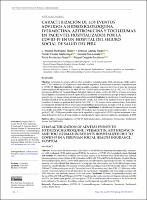| dc.contributor.author | Rodríguez-Tanta, L. Yesenia | |
| dc.contributor.author | Cachay Rojas, Enrique | |
| dc.contributor.author | Fiestas Saldarriaga, Fabián | |
| dc.contributor.author | Alva Lozada, Guisela | |
| dc.contributor.author | Fernández-Rojas, Paola | |
| dc.contributor.author | Delgado-Escalante, Raquel | |
| dc.date.accessioned | 2023-11-30T02:06:22Z | |
| dc.date.available | 2023-11-30T02:06:22Z | |
| dc.date.issued | 2023-03-28 | |
| dc.identifier.citation | Revista Peruana de Medicina Experimental y Salud Pública. 2023; 40(1). | es_PE |
| dc.identifier.uri | https://hdl.handle.net/20.500.12959/4620 | |
| dc.description.abstract | Objetivos. Caracterizar los eventos adversos (EA) asociados a hidroxicloroquina (HQ), azitromicina (AZI), tocilizu-mab (TOB) e ivermectina (IVM) prescritos como «fuera de etiqueta» en el tratamiento de pacientes hospitalizados por la COVID-19. Materiales y métodos. Se realizó unanálisis secundario transversal de la base de datos del sistema de farmacovigilancia del Seguro Social de Salud del Perú (EsSalud) de las notificaciones de EA a HQ, AZI, TOB e IVM provenientes del Hospital Nacional Edgardo Rebagliati Martins de abril a octubre del 2020. Se revisaron las historias clínicas digitales, se estimaron las tasas de reporte de EA y se evaluaron sus características por tipo de fármaco, tiempo de aparición, tipo por órgano-sistema afectado, gravedad y causalidad. Resultados. Se identificaron 154 notificaciones que describen un total de 183 EA posiblemente relacionados con HQ, AZI, TOB e IVM, siendo 8% la tasa de reporte de EA. La mediana de tiempo de aparición de EA fue de 3 días (RIC: 2–5). La mayoría fueron cardiovasculares, destacándose la prolongación del intervalo QT. Se observaron EA hepatobiliares principalmente asociados a TOB. La mayoría de los casos fueron moderados, no obstante, el 10,4% fue grave. Conclusiones. Se identificaron EA potencialmente asociados al uso de HQ, AZI, TOB e IVM contra la COVID-19, siendo los más frecuentes los de tipo cardiovasculares. A pesar de que la AZI, HQ e IVM poseen perfiles conocidos de seguridad, su empleo en la COVID-19 podría incrementar la apa-rición de EA por los factores de riesgo propios de esta infección. Se sugiere reforzar la vigilancia, especialmente, de TOB. | es_PE |
| dc.description.abstract | Objective. To characterize the adverse events (AEs) related to the off-label use of hydroxychloroquine (HQ), azithromy-cin (AZI), tocilizumab (TOB) and ivermectin (IVM) for the treatment of COVID-19 in hospitalized patients. Materials and Methods. We conducted a secondary cross-sectional analysis of the Peruvian Social Health Insurance (EsSalud) pharmacovigilance system database of AE notifications to HQ, AZI, TOB and IVM in the Edgardo Rebagliati Martins National Hospital from April to October 2020. Information was collected from digital medical records. We estimated AE reporting rates and evaluated their characteristics by drug type, time of occurrence, type by the affected organ-system, severity and causality. Results. We identified 154 notifications describing a total of 183 AE possibly related to HQ, AZI, TOB and IVM; the reporting rate was 8%. The median time of AE occurrence was 3 days (IQR: 2-5). Most were cardio-vascular events; prolongation of the QT interval was the most frequent. Hepatobiliary AEs were mainly associated with TOB. Most cases were moderate, however, 10.4% were severe. Conclusions. We found AEs potentially associated with the use of HQ, AZI, TOB and IVM against COVID-19; cardiovascular events were the most frequent. Although AZI, HQ and IVM have known safety profiles, their use against COVID-19 could increase the occurrence of AE due to the risk factors inherent to this infection. Surveillance systems must be improved, especially those for TOB. | es_PE |
| dc.format | application/pdf | es_PE |
| dc.language.iso | spa | es_PE |
| dc.publisher | Instituto Nacional de Salud | es_PE |
| dc.relation.uri | https://rpmesp.ins.gob.pe/index.php/rpmesp/article/view/11563 | es_PE |
| dc.rights | info:eu-repo/semantics/openAccess | es_PE |
| dc.rights.uri | https://creativecommons.org/licenses/by-nc-sa/4.0/ | es_PE |
| dc.subject | Farmacovigilancia | es_PE |
| dc.subject | Covid-19 | es_PE |
| dc.subject | Hidroxicloroquina | es_PE |
| dc.subject | Azitromicina | es_PE |
| dc.subject | Ivermectina | es_PE |
| dc.subject | Tocilizumab | es_PE |
| dc.subject | Pharmacovigilance | es_PE |
| dc.subject | Hydroxychloroquine | es_PE |
| dc.subject | Azithromycin | es_PE |
| dc.subject | Ivermectin | es_PE |
| dc.title | Caracterización de los eventos adversos a hidroxicloroquina, ivermectina, azitromicina y tocilizumab en pacientes hospitalizados por la covid-19 en un hospital del Seguro Social de Salud del Perú | es_PE |
| dc.title.alternative | Characterization of adverse events to hydroxychloroquine, ivermectin, azithromycin and tocilizumab in patients hospitalized due to COVID-19 in a Peruvian Social Health Insurance hospital | es_PE |
| dc.type | info:eu-repo/semantics/article | es_PE |
| dc.subject.ocde | https://purl.org/pe-repo/ocde/ford#3.01.05 | es_PE |
| dc.subject.ocde | https://purl.org/pe-repo/ocde/ford#3.03.08 | es_PE |
| dc.identifier.doi | https://doi.org/10.17843/rpmesp.2023.401.11563 | |






